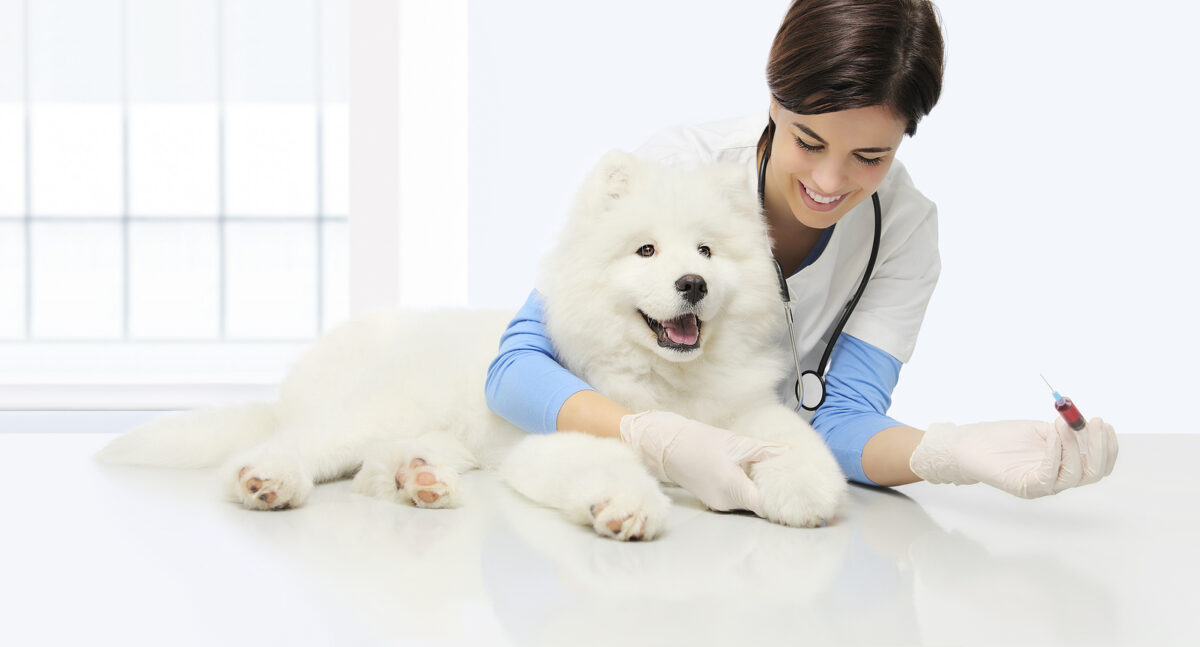Can your dog learn to accept blood draws calmly? Absolutely. And it’s an important skill for them to have throughout life. Dogs typically need to have blood drawn regularly for wellness and to test for heartworms. Of course, you won’t actually be poking them with needles at home, but by training them to accept the handling used by veterinary staff to draw blood, you can help to reduce their fear, anxiety, and stress.
Common blood draw locations for dogs are jugular veins, which run on either side of the windpipe. To help your small dog learn to accept being gently held for jugular blood draws, seat them on a non-slip dog bed on the counter and stand behind them. Next, encircle their muzzle with one hand while your other hand gently holds the back of their head for a second, then treat.
Gradually increase the amount of time your dog tolerates having their head held until you’ve reached 30 seconds. For medium-size or large dogs, teach them to sit with their rear end in a corner and stand on either side of them while facing forward. Cup their lower jaw on either side with your fingers while your thumbs rest on top of their muzzle, then treat. Gradually build up to 30 seconds and stop before your dog starts getting wiggly.
Next, train from the perspective of the person drawing blood. While facing your dog, move your thumb apart from the other fingers to make a Y. Gently press your hand against your dog’s throat just above the collar bone, then treat and release. After they’re used to the pressure, apply the Y, rub either side of their neck with fingers held perpendicular to the vein, then treat and release.
Another common site for blood to be drawn is the cephalic vein, which runs on top of the foreleg. Standing next to your dog, hug their head from underneath with your left arm while your right hand picks up their right leg under the elbow, then treat. Gradually get them used to having their right leg pushed forward a few inches.
Next, try “rolling” the vein with your thumb from the inside of the leg towards the outside by moving the skin just below the elbow. Practice using treats until your dog is used to the gentle hold and having their leg held/ rolled for 30 seconds, then repeat with the other leg.
If your dog is trained to shake, you’re halfway to the other part of cephalic blood draw training: holding the leg from the front. While facing your dog, have them shake, then briefly cup their foreleg with one hand and treat. Slowly increase the amount of time their leg is held until you’ve reached 30 seconds. Using your other hand, rub the top of their stabilized foreleg and treat. Most dogs don’t like having their legs held so watch for signs of stress and keep sessions short and positive.
The last common site for blood draw in dogs is their lateral saphenous vein, which runs diagonally along the outer back leg just above the hock. With your dog standing, place yourself next to your dog and hug their head. Trail your other hand along their spine to their outer back leg, then gently squeeze below their knee and treat. Repeat until your dog is used to the hold/ leg squeezing for 30 seconds.
To train for drawing blood, position yourself next to your dog’s back leg while they are standing. Gently squeeze their leg below the knee and treat and release. Next, squeeze their leg, stroke the skin above their hock with the fingers of your other hand, and treat and release.
For all types of blood draws, the veterinary staff will usually apply liquid, such as water, alcohol, or disinfecting solutions, to the vein to make it stand up. Having their skin suddenly wetted down can be scary, so do additional training using a little squeeze bottle of water. You can also use a ballpoint pen to gently touch their neck or their leg to simulate a needle poke. If you have a partner to help with training, one person can practice the gentle hold while the other pretends to draw blood.
As with vaccines, needle pokes can be painful, so ask your vet for a recommended topical lidocaine cream that can be applied to areas of blood draw several hours before their visit to help make their experience even more Fear Free. If your dog has had fear or aggression in the past when held or restrained, it’s a good idea to seek assistance from a trusted Fear Free professional rather than trying to implement these techniques by yourself.
This article was reviewed/edited by board-certified veterinary behaviorist Dr. Kenneth Martin and/or veterinary technician specialist in behavior Debbie Martin, LVT.








